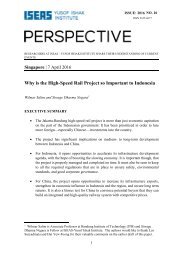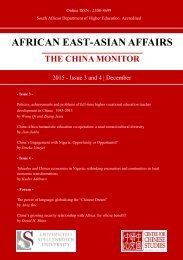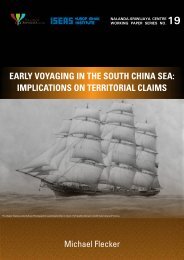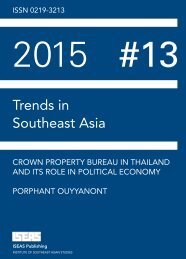Create successful ePaper yourself
Turn your PDF publications into a flip-book with our unique Google optimized e-Paper software.
As to MCP’s delegates <strong>in</strong> Shanghai, accord<strong>in</strong>g to Yong, <strong>in</strong> 1934, <strong>the</strong> MCP sent an important<br />
official (CC member), Li Su-kong ( 李 书 光 ), to cement fur<strong>the</strong>r ties with Com<strong>in</strong>tern’s Shanghai<br />
networks. 37 Li Shu Kong should be this Li Su-kong. And Kok Bun also might probably be Li Sukong.<br />
Meanwhile, <strong>as</strong> quoted above (3.(3) and (4)), Bun Teck-chai (Li Chi-s<strong>in</strong>) went back to<br />
Shanghai <strong>in</strong> 1934. Kok Bun might be Bun Teck-chai <strong>as</strong> well. We can discern here that <strong>as</strong> many <strong>as</strong><br />
n<strong>in</strong>e persons successively stayed <strong>in</strong> Shanghai at that time, that is, Li Chi-s<strong>in</strong>, Koak J<strong>in</strong>, Tuh Sung,<br />
Chiu Sung (<strong>the</strong>se three had already returned), Li Su-kong (= Kok Bun?), Iun Ch<strong>in</strong> Sun, Lau Chu<br />
An, Tan S<strong>in</strong> Hoa and Oh (Li) Kok Cheng. In Yong’s research, secretary of <strong>the</strong> MCP <strong>in</strong> 1934 w<strong>as</strong><br />
not identified. Accord<strong>in</strong>g to one of <strong>the</strong> former MCP leaders, Zhang M<strong>in</strong>g J<strong>in</strong> ( 张 明 今 ), secretary of<br />
this period w<strong>as</strong> Liu Teng-chan ( 刘 登 乘 ). 38 If this is correct, Kok Kong might be Liu’s pseudonym.<br />
But <strong>the</strong> above quoted record of <strong>the</strong> MCP (3.(3)) mentioned that s<strong>in</strong>ce early 1934 act<strong>in</strong>g secretary<br />
w<strong>as</strong> Chun Guang (Lim Choon Kwong). Possibility of Kok Kong (Guo Guang) be<strong>in</strong>g pseudonym of<br />
Chun Guang might be higher.<br />
Two questions arise here.<br />
(1) British Consul-General’s ano<strong>the</strong>r letter to <strong>the</strong> SMP dated 25 September 39 said;<br />
“[MCP’s] orig<strong>in</strong>al [letter] w<strong>as</strong> <strong>in</strong> code numbers which have been decyphered, <strong>as</strong><br />
well <strong>as</strong> <strong>in</strong> secret <strong>in</strong>k, which h<strong>as</strong> been developed”. Why were letters written <strong>in</strong><br />
number code deciphered?<br />
Accord<strong>in</strong>g to em<strong>in</strong>ent historian, Dr. Leon Comber, who w<strong>as</strong> once affiliated with <strong>the</strong><br />
SB, “Ch<strong>in</strong>ese Commercial Code” w<strong>as</strong> widely used among Ch<strong>in</strong>ese bus<strong>in</strong>essmen <strong>in</strong><br />
this period, especially for send<strong>in</strong>g telegrams. Each Ch<strong>in</strong>ese character w<strong>as</strong> given<br />
specific number. Code number books, which showed common code number, were<br />
e<strong>as</strong>ily obta<strong>in</strong>able. <strong>The</strong> MCP might have used this commercial code. 40 If so, <strong>in</strong><br />
h<strong>in</strong>dsight, <strong>the</strong>y were not cautious enough.<br />
(2) Why were <strong>the</strong>se letters not kept <strong>in</strong> <strong>the</strong> Com<strong>in</strong>tern <strong>Files</strong>?<br />
SMP officials said though <strong>the</strong>se were delivered to <strong>the</strong> addressed places, no one appeared to claim<br />
<strong>the</strong>m. It meant <strong>the</strong> relevant persons of <strong>the</strong> Com<strong>in</strong>tern <strong>as</strong> well <strong>as</strong> <strong>the</strong> MCP <strong>in</strong> Shanghai sensed <strong>the</strong><br />
93








